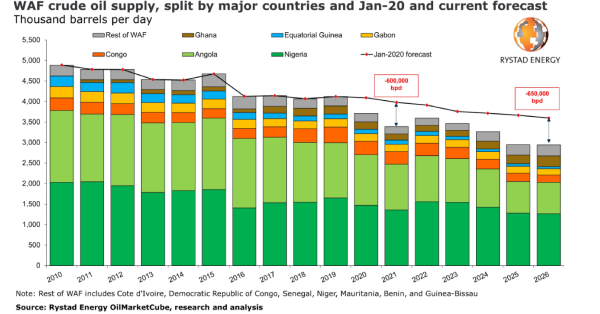Global oil production is slowly recovering towards pre-Covid-19 levels, but in West Africa the pandemic is set to leave lasting effects. This important region for sweet crude oil production faces numerous challenges as it strives to heal from the pandemic, including underinvestment, a lack of infill drilling at mature fields, and infrastructure that is either ageing or threatened, a Rystad Energy analysis showed.
Sweet crude is the preferred oil grade to make jet fuel – the worst-hit segment as oil demand plunged last year. West African crude oil production dropped to 3.71 million barrels per day (bpd) last year from 4.12 million bpd in 2019, and is set to decline further to 3.39 million bpd this year. While we expect output to tick back up in 2022 and 2023 as jet fuel demand returns, production is set to fall below 3 million bpd already from 2025 unless heavyweights Nigeria and Angola can stage a strong comeback and shake off the dismal growth trends of the past decade.
West Africa’s oil production was not destined to follow this current grim projection before Covid-19 hit – in fact, the region was in line for more investment and activity. Last year’s low oil prices and the unstable market conditions that have continued into 2021 changed the outlook, however, as major operators decided to practice capital discipline and limit their investment exposure in regions including West Africa.
As a result, Rystad Energy has reduced its forecast for West African crude oil output by 600,000 bpd for 2021 and by 650,000 bpd for 2026, compared with our pre-Covid-19 projections.
“The structural upstream obstacles that West Africa faces are realities that are not going away in the short term. Even if jet fuel makes a spectacular recovery and demand for light and medium sweet crude grades returns, Nigeria and Angola, as well as other neighbors in structural upstream decline, will not be in a position to supply the market,” says Nishant Bhushan, upstream analyst at Rystad Energy.
Source: Rystad Energy









































